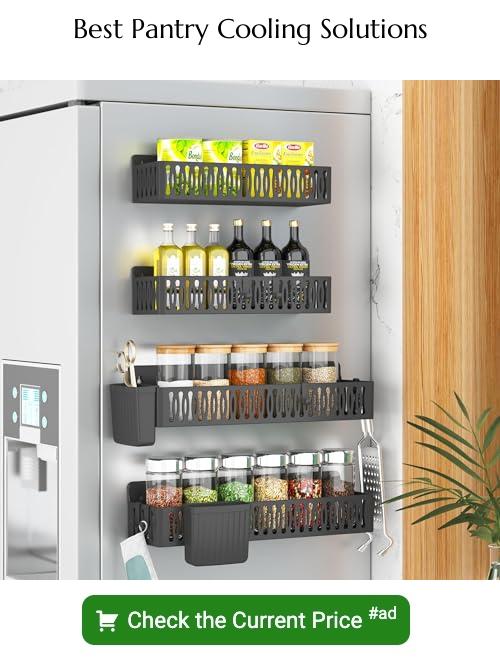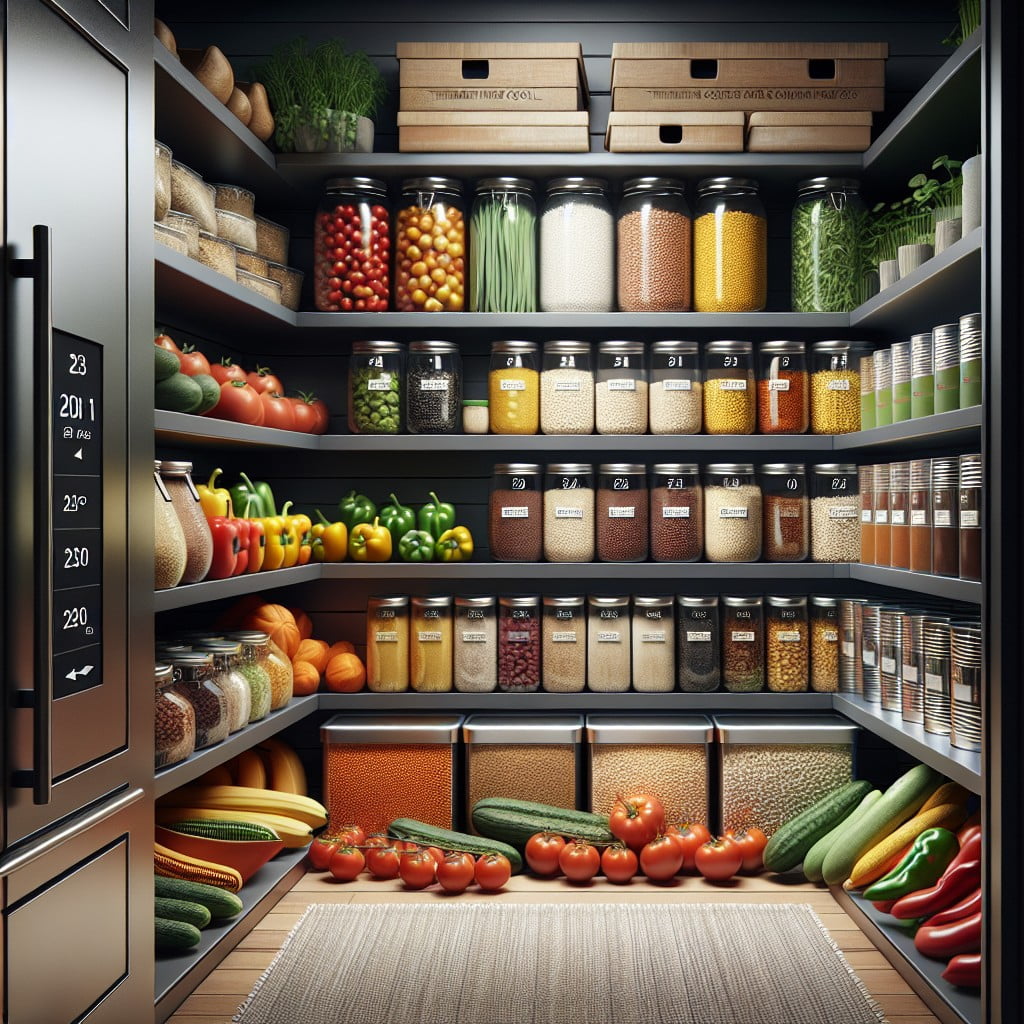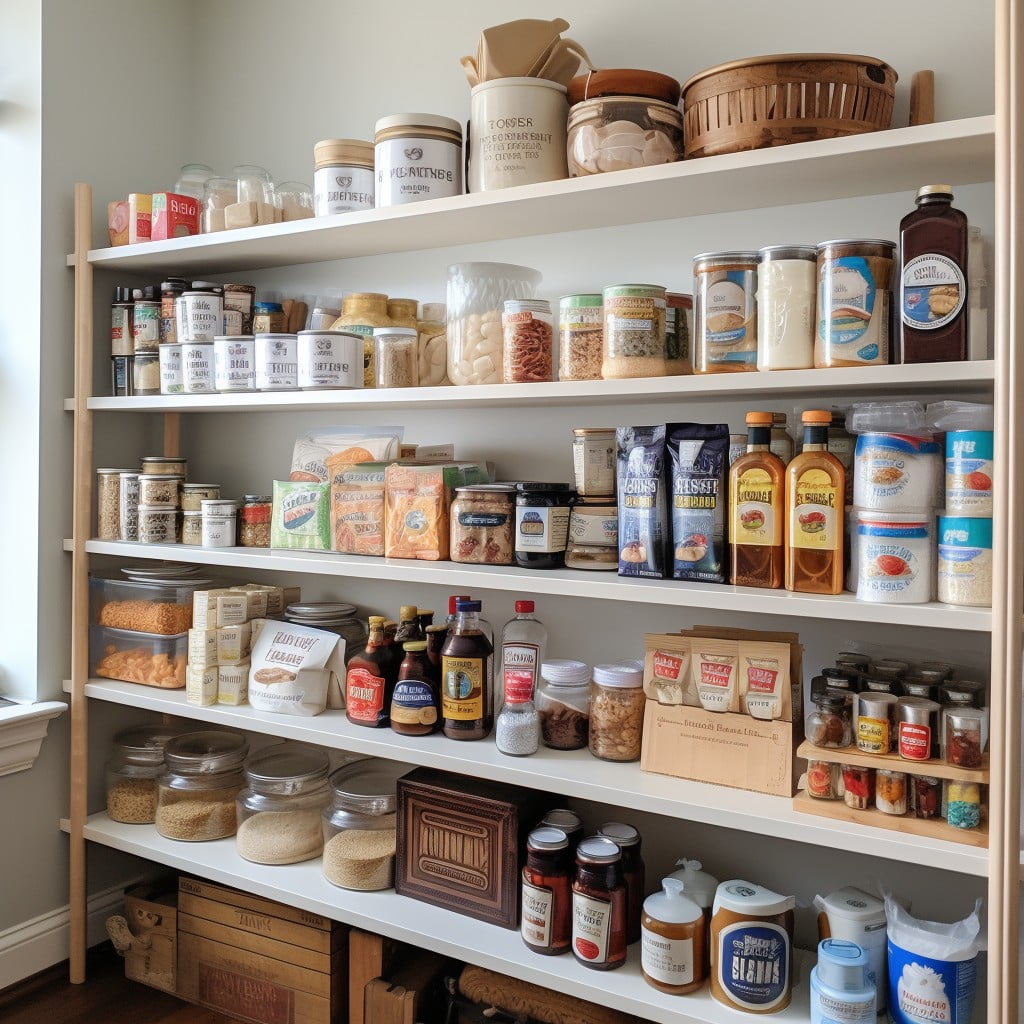Last updated on
Explore practical strategies to maintain a cool pantry during the sweltering summer months, ensuring food freshness and thwarting spoilage.
Keeping your pantry cool during the hot summer months is crucial to prevent spoilage and maintain the quality of your food items. The key is to create an environment that is dark, dry, and cool. This can be achieved by utilizing various strategies such as proper ventilation, insulation, strategic placement of items, and use of cooling appliances.
This article will guide you through these methods, providing you with comprehensive steps to ensure your pantry remains cool all summer long. So, let’s dive into the details and find out how you can keep your pantry fresh and cool, even when the temperature outside is soaring.
Key takeaways:
- Install vents for better air circulation.
- Block out heat with window film.
- Use silica gel packets and a dehumidifier to manage humidity.
- Streamline shelves for efficient air circulation.
- Monitor pantry temperature with a thermometer.
Increase Your Pantry’s Ventilation
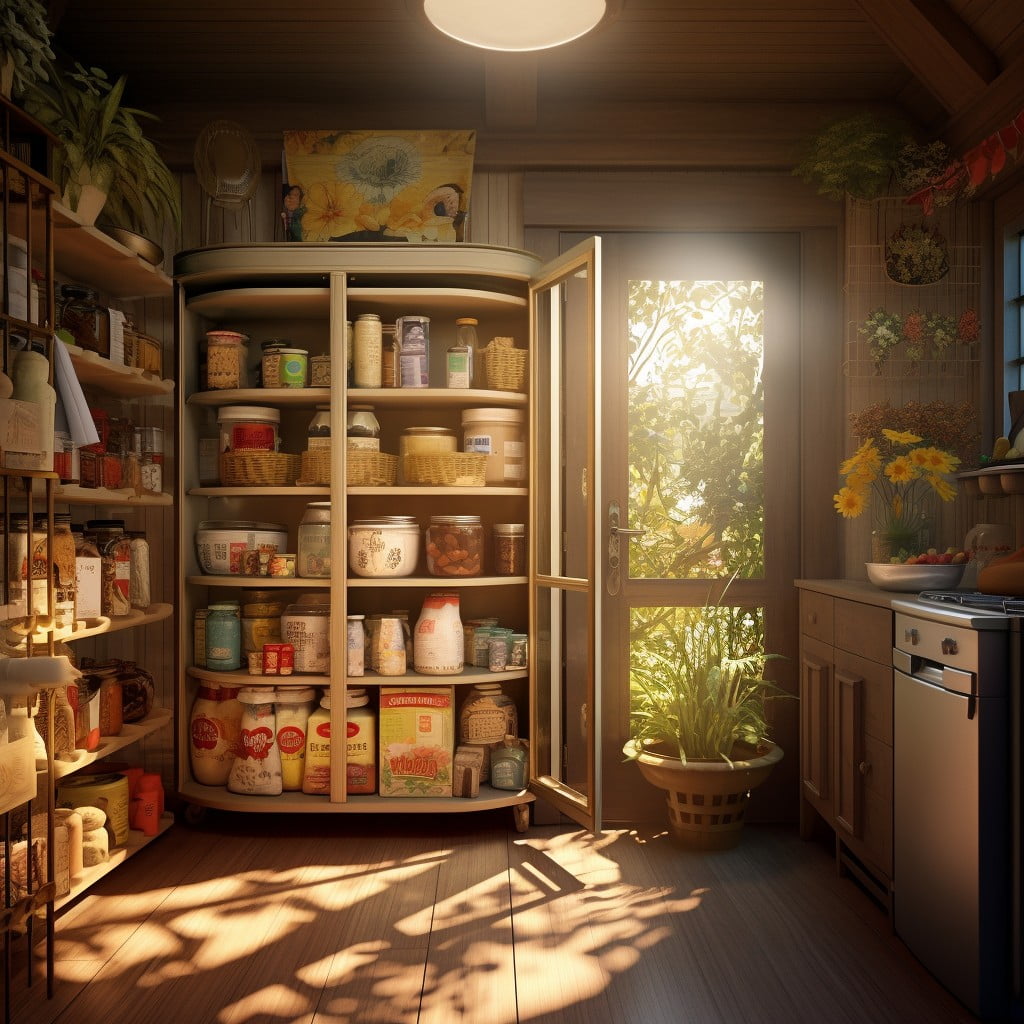
First, consider the current configuration of your pantry. Ideally, look for spots with natural airflow that would make suitable ventilation zones. If these aren’t available, you can create your own using various techniques:
1. Install vents: Adding vents on opposite ends of the pantry allows the air to circulate more freely, driving away the buildup of warm air.
2. Use a fan: A small, energy-efficient fan can help to move the air around, aiding in maintaining cooler conditions.
3. Incorporate a door vent: This convenient solution requires a specialist for installation, but it can significantly increase airflow.
4. Ensure clearance: Keeping shelves and food items a few inches away from the wall can aid in the circulation of air.
Remember that proper installation and positioning of vents or fans is crucial to maximize the optimal airflow in your pantry.
Block Out Heat With Window Film
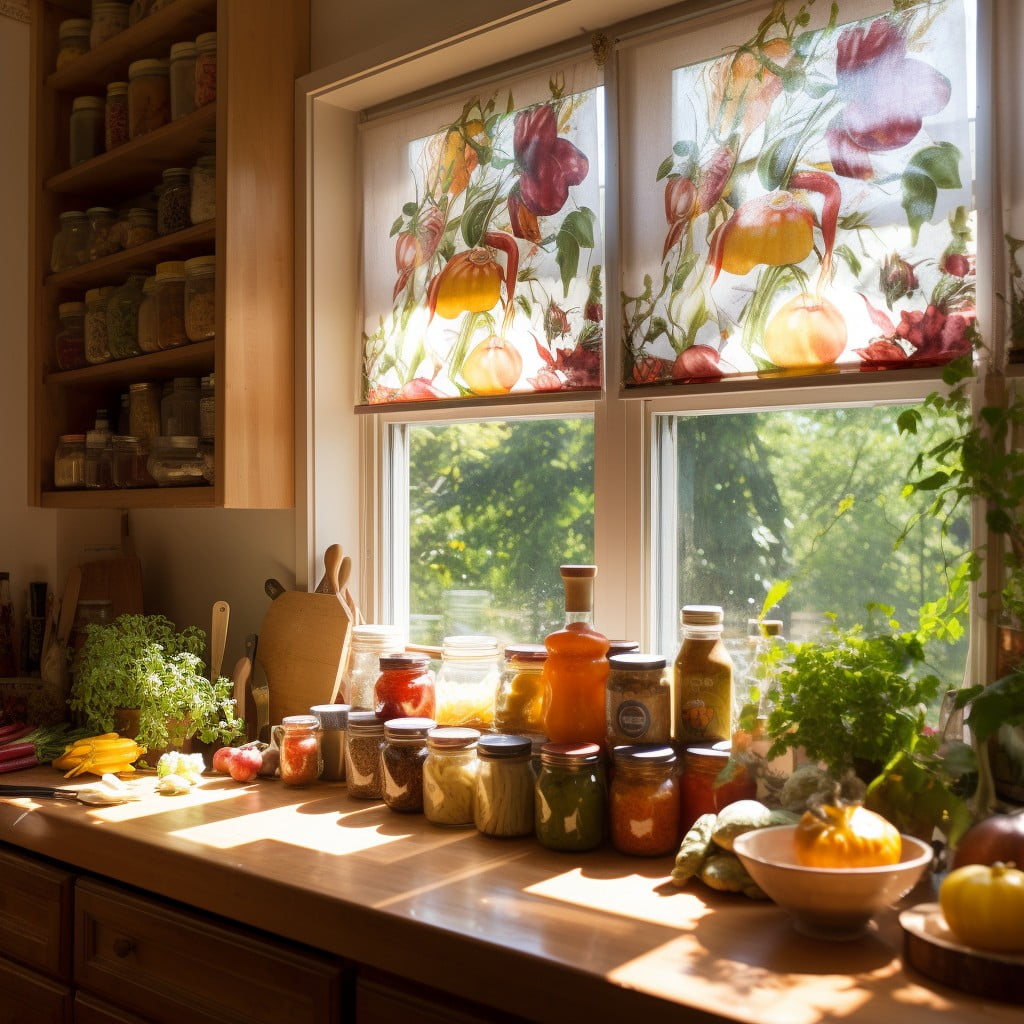
Window film offers a simple and cost-effective solution. Acting similarly to sunglasses for your pantry windows, they reduce glare and UV radiation. This not only cools your pantry but also safeguards food from direct sun rays which may cause spoiling.
There are varying types, from darker tinted to reflective versions that offer more privacy. Also, there are versions which not only reduce heat during summer but also retain it during winter, providing year-round benefits.
To apply:
- Measure your window to determine the size of film needed.
- Cut the window film to size.
- Clean the window surface thoroughly.
- Apply a layer of application solution to the window.
- Then, gently place the window film, use an application tool to smooth it out.
- Finally, allow it to dry – this usually takes a few days.
Remember, installation requires precision to avoid bubbles and creases. Seek professional help if unsure.
Manage Your Pantry’s Humidity
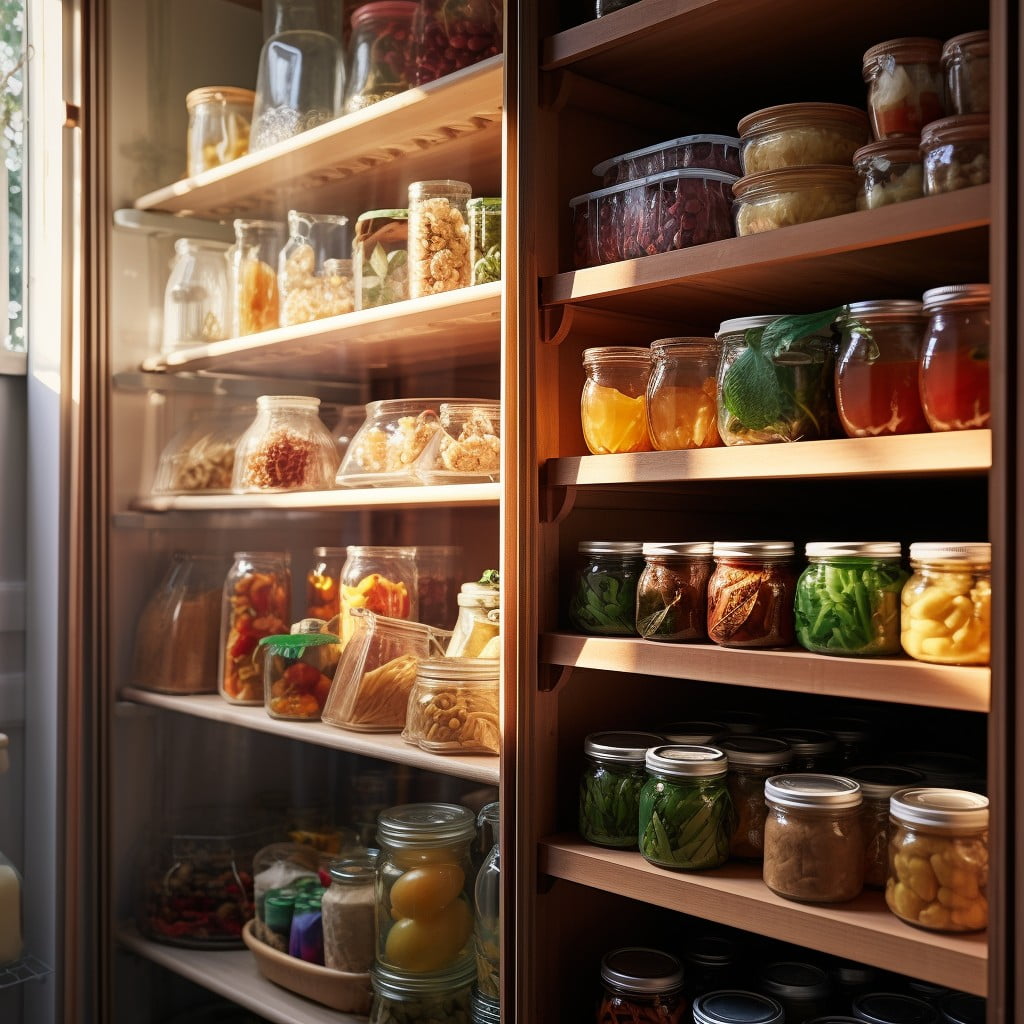
To efficiently manage humidity, consider the following:
1. Use Silica Gel Packets: These are great moisture absorbers. Placing them in corners helps keep dry goods less susceptible to spoilage. Change them regularly to maintain their effectiveness.
2. Install a Dehumidifier: This reduces moisture levels significantly. Smaller, pantry-friendly versions are readily available in the market.
3. Seal Dried Goods: Secure your cereals, flour, and other dried items in airtight containers to prevent them from absorbing moisture.
4. Use of Salt Lamps: A natural dehumidifier, it absorbs excess moisture and releases the trapped moisture when the lamp is on.
5. Ventilation: Regular airing out of your pantry prevents dampness and reduces humidity levels.
Streamline Your Pantry’s Shelves
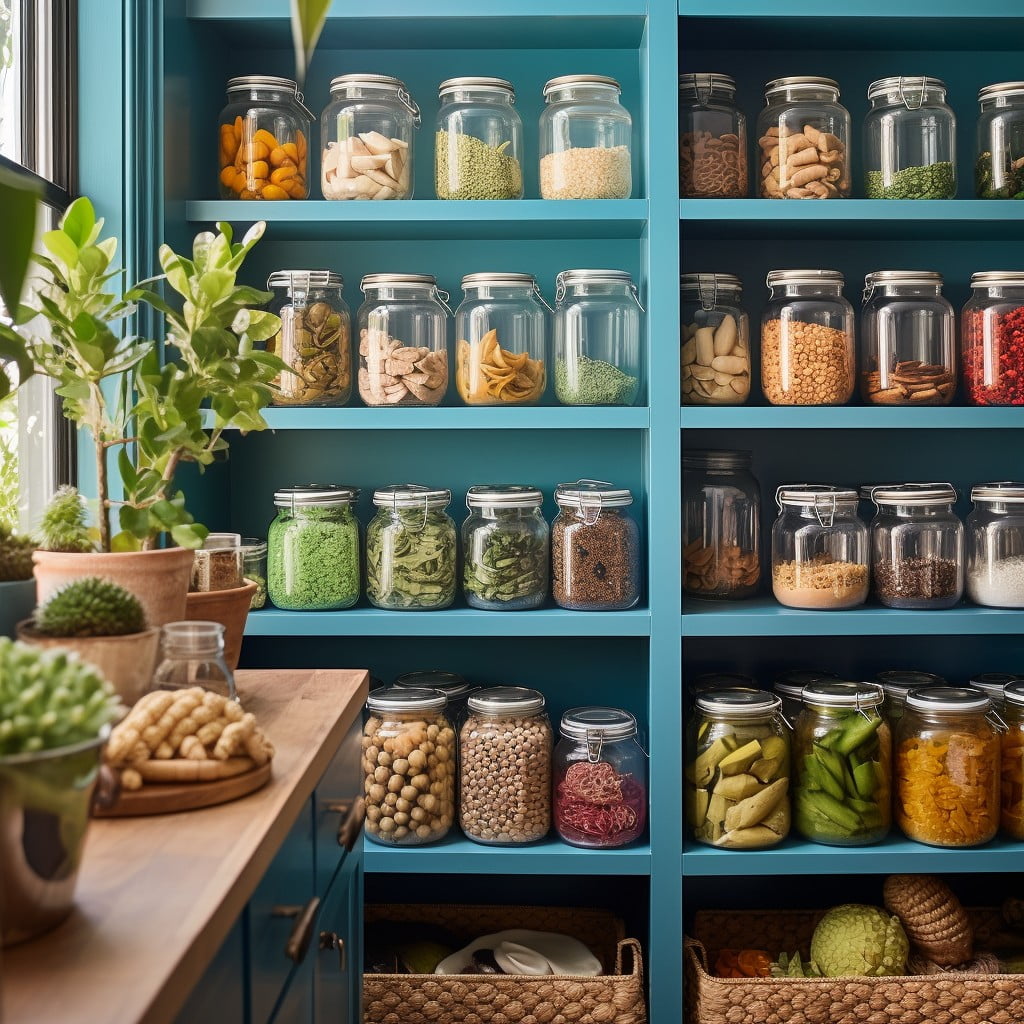
Efficient use of space is essential when looking to maintain cool temperatures within a pantry. Closer-packed items restrict air flow, potentially causing pockets of warm air. Follow these steps to organize efficiently:
1. Remove unnecessary items: Keep only the essentials, lessen the items competing for cool air.
2. Arrange items with space in between: This allows cool air to circulate freely.
3. Utilize wire shelving: Wire shelves improve air circulation compared to solid shelves.
4. Opt for tiered storage: This allows for better air circulation underneath items.
5. Adopt a FIFO system (First In, First Out): This ensures items don’t sit too long, absorbing and retaining heat.
Remember, a well-structured pantry encourages air flow and can help keep the space more cool and favorable for your supplies.
Monitor Your Pantry’s Temperature Day to Day
Utilize a pantry thermometer to keep track of temperature fluctuations. This tool provides accurate readings, allowing adjustments to be made promptly.
- Choose an easy-to-read digital model. The display should be clear and accessible, without requiring you to rearrange items or step into the pantry.
- Place the thermometer away from the pantry door and walls. Temperature changes are often most noticeable in these areas.
- Monitor temperature at least once a day, ideally around the same time. This provides a consistent reference point for analysis.
- If temperatures exceed 70°F (21°C), airflow improvement or additional insulation may be required. A consistent reading above this threshold can lead to spoilage.
- React quickly to high readings to minimize the risk of food spoilage. Sudden temperature spikes may indicate a faulty cooling system or poor pantry ventilation.
Store Appliances Elsewhere
Relocating heat-producing appliances can considerably reduce your pantry’s temperature. Appliances such as microwaves, ovens, and dishwashers should ideally be positioned outside the pantry area. These appliances generate a surprising amount of heat during operation which can warm up the pantry and consequently its items.
Microwaves: Besides giving off heat when in use, they also transfer warmth to items around them, it’s advisable to move them to an open counter space.
Ovens: These are major heat contributors. Movement might be restricted due to installation, but using them less during peak summer days can contribute significantly to a cooler pantry.
Dishwashers: Known for generating heat and steam, which can elevate temperatures and humidity, dishwashers should ideally be placed far from the pantry.
By considering appliance placement, you can successfully mitigate heat sources and achieve lower pantry temperatures. Remember, a slightly inconvenient kitchen layout is favorable to spoiled food.
Addressing Moisture and Rust in Your Pantry
Prevention and regular maintenance are vital against moisture and rust. Use airtight containers; these help maintain the dryness of food grains while preventing humidity.
Improve circulation – congested pantries tend to attract moisture. Ensure shelf surfaces are always dry as dampness leads to rust, particularly on metal shelf brackets. Install rust-resistant metal fixtures or use anti-rust paint on existing metal parts.
Regularly check for leaks in nearby plumbing or roof areas, as unnoticed leakage can result in accumulation of moisture. If any signs of rust or moisture are found, act promptly to halt any further damage. Silica gel sachets can be a good addition, as they absorb moisture effectively, maintaining a dry atmosphere.
Regularly clean and air out your pantry— about once a month— to prevent the buildup of moisture.
Dealing With Mold or Mildew in Your Pantry
Regular cleaning and proper food storage can minimize the likelihood of mold or mildew. Despite these measures, if they appear, they must be addressed quickly to prevent further spread.
1. Dispose of any food exposed to mold immediately. Destroys spores.
2. Empty pantry. It supplies fresh air and light, which are natural mold disinfectants.
3. Clean thoroughly using a mild bleach solution. Destroys mold deeply rooted in surfaces.
4. Allow it to dry completely. Mold thrives in moist environments.
5. Maintain a constant pantry temperature. It inhibits mold and mildew growth.
6. Dehumidify if necessary. It prevents moisture buildup.
Dry goods in hermetically sealed containers can help in avoiding such situations. Regular maintenance is crucial to ensure the freshness of food and overall pantry hygiene.
Note: While cleaning mold, always protect yourself by wearing gloves and a mask to prevent respiratory issues. Always ensure you dispose of contaminated materials properly.
Solving Issues With Pantry Temperature
Firstly, consider insulating pantry walls and ceilings to prevent heat transfer from the rest of the house.
Next, install a digital thermometer to continuously monitor temperature levels.
The use of blackout curtains or blinds over any windows in the pantry can significantly block sunlight and heat.
Then, evaluate the use of compact refrigeration units specifically for heat-sensitive items.
Lastly, if the pantry shares a wall with a heat-generating appliance like an oven, seek professional advice to install heat-resistant material between them.
Remember that energy-efficient LED lights generate less heat, keeping the temperature down during evening pantry trips.
What Temperature Should a Pantry Be in Summer?
Ideal for pantry storage, a temperature range of 50-70 degrees Fahrenheit inhibits bacteria growth and ensures food preservation. Higher temperatures, common in summer, can lead to problems like increased humidity and spoiled goods. Consider implementing the following measures to maintain appropriate storage conditions:
- Insulation: Proper insulation can moderate temperature fluctuations and keep the pantry cool during hot summer months.
- Light management: Limit exposure to direct sunlight, which can raise the temperature.
- Ventilation: Encourage air flow to avoid pockets of hot air.
- Use of cooling aids: An air conditioner, fan, or dehumidifier can help control heat and humidity levels.
- Thermometer placement: Regular monitoring of pantry temperature with a thermometer facilitates timely corrective action.
- Avoid appliance heat: Keep appliances that radiate heat, like refrigerators or ovens, away from the pantry.
- Proper storage: Implement the FIFO (First In, First Out) method. Older items should be used first to prevent spoilage.
- Regular maintenance: Regularly inspect, clean and maintain your pantry to ensure ideal conditions.
How to Dehumidify Your Pantry
To reduce humidity levels, consider implementing these strategies:
1. Utilize a dehumidifier: There are compact dehumidifiers on the market that can fit into smaller spaces, like a pantry. These devices extract moisture from the surrounding air, keeping your food items dry and less prone to spoilage.
2. Absorb moisture with silica gel packets: Easily found online or in stores, these packs will absorb excess moisture. Tuck them in corners and hard-to-reach spaces where humidity may gather.
3. Mind your produce storage: Certain types of produce, like onions or potatoes, emit moisture as they ripen. Store these items in a separate location or ensure they’re properly sealed if kept in the pantry.
4. Ventilate your pantry: Allow airflow by opening pantry doors intermittently, or install a small vent if possible. Good ventilation promotes evaporation, thus reducing dampness.
Remember, a dry pantry is key to preventing mold, mildew, and the premature spoilage of food items. Regularly monitoring and managing pantry humidity can contribute significantly to food longevity and kitchen efficiency.
Types of Pantry Ventilation: Passive and Active
Passive ventilation requires no energy consumption and works by utilizing natural air flow. This can be managed through proper use of windows, doors, and vents, allowing cool air to circulate freely.
Active ventilation systems, on the other hand, employ devices such as fans or air conditioners to circulate air and manage temperature. Although effective, these systems tend to consume electricity and might increase energy expenditure.
The balance between these two types of pantry ventilation will likely be determined by your specific pantry conditions, as well as your energy consumption preferences and budget.
Maintaining the Ideal Temperature and Humidity in a Pantry
Keeping the pantry temperature between 50-70°F (10-20°C) inhibits bacteria growth on food. Meanwhile, a relative humidity between 50-60% prevents moisture accumulation, reducing the risk for mold and mildew.
Key points:
- An inexpensive thermometer and hygrometer set can easily monitor temperature and humidity levels.
- Long-term temperature fluctuations may be limited with adequate insulation.
- Pantry items, especially staples like flour, sugar, and rice, last longer in such conditions.
- Too low humidity can cause dry goods to dehydrate.
- Too high humidity can cause cans and metal items to form rust.
- Both temperature and humidity can be managed with passive and active ventilation methods.
- Regular checks and action when needed maintain optimal conditions.
- A dehumidifier can help lower humidity if ventilation is not enough.
These will ensure the best environment for food storage in your pantry.
FAQ
Why does my pantry get hot?
Your pantry gets hot due to inadequate ventilation and limited airflow, thus exposing your pantry shelving to fresh air could mitigate this issue.
What temp should pantry be?
The ideal temperature for a pantry should be between 50 to 70 °F to ensure proper food storage and slow down deterioration.
Should pantries have windows?
While it’s possible to have a window in a pantry, it’s not typically necessary as it could reduce functionality due to potential issues like loss of storage space and increased risk of bugs and leaks.
How can insulation help in keeping the pantry cool during summer?
Insulation can help keep the pantry cool during summer by reducing heat transfer from outside, thus maintaining a lower, more stable temperature inside.
What are the potential risks if the pantry overheats?
Overheating in the pantry can lead to spoilage of food items, promote the growth of bacteria and pests, and potentially increase the risk of fire.
Can ventilations systems help maintain the temperature of the pantry?
Yes, ventilation systems can help maintain the temperature of the pantry by circulating air and reducing humidity levels.
Liked reading this? Here’s more:
Recap:
